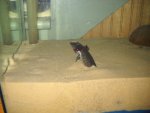eyrops
Member
I have been interested for some time in constructing a setup for Siren lacertina that facilitated burrowing behavior. I’ve made several attempts with mixed results. My latest try appears to be working fine so far, so I’m writing about it here.
I used a 29 gallon (110 liter) tank. I installed an undergravel filter assembly. I covered this with a filter pad that was about ½” (1.5 cm) thick. My goal was to send water down one of the airlifts and let it upwell through the sand. I used a powerhead water pump to do this. I installed plastic film for a few inches around the airlift so the water wouldn’t upwell right next to the airlift. I used silicone sealant to hold the filter pad in place, to seal the water tube connections, and to plug the unused airlifts. When the sealant was cured, I added about 4 inches (10 cm) of fine sand, and filled the tank with water.
The water does upwell through the sand, making little “springs”. The location of these springs changes, but right now they are concentrated on the end of the tank opposite the airlift. The “springs” float the sand, and this unconsolidated substrate gives the siren an easy place to enter the sand. It does enter the sand and burrow through it. Sometimes it is hidden, sometimes both had and tail stick out, and quite often just the head and limbs stick out as in the attached photo. It also spends some time totally above the substrate.
I believe that some form of accessible substrate may be a good thing for keeping sirens. Burrowing is something they do in the wild, and it may cut their stress level in captivity if they are able to burrow. I don’t think the way I set this tank up is the only or necessarily the best way to do it. I’d be interested in hearing from others that have attempted to address this issue. I believe mud substrates have been used. I did not try this, mostly because I could imagine several ways it could fail spectacularly. I’m most interested in ideas based on experience with aquatic burrowers, but all ideas are welcome!
I used a 29 gallon (110 liter) tank. I installed an undergravel filter assembly. I covered this with a filter pad that was about ½” (1.5 cm) thick. My goal was to send water down one of the airlifts and let it upwell through the sand. I used a powerhead water pump to do this. I installed plastic film for a few inches around the airlift so the water wouldn’t upwell right next to the airlift. I used silicone sealant to hold the filter pad in place, to seal the water tube connections, and to plug the unused airlifts. When the sealant was cured, I added about 4 inches (10 cm) of fine sand, and filled the tank with water.
The water does upwell through the sand, making little “springs”. The location of these springs changes, but right now they are concentrated on the end of the tank opposite the airlift. The “springs” float the sand, and this unconsolidated substrate gives the siren an easy place to enter the sand. It does enter the sand and burrow through it. Sometimes it is hidden, sometimes both had and tail stick out, and quite often just the head and limbs stick out as in the attached photo. It also spends some time totally above the substrate.
I believe that some form of accessible substrate may be a good thing for keeping sirens. Burrowing is something they do in the wild, and it may cut their stress level in captivity if they are able to burrow. I don’t think the way I set this tank up is the only or necessarily the best way to do it. I’d be interested in hearing from others that have attempted to address this issue. I believe mud substrates have been used. I did not try this, mostly because I could imagine several ways it could fail spectacularly. I’m most interested in ideas based on experience with aquatic burrowers, but all ideas are welcome!






